|
|
||||
| home > architetture | ||||
| CARLINI & VALLE. Piazza a Treppo Carnico |
||||
| [in italiano] | TREPPO CARNICO, A SQUARE OVER THE ALPS. From a distance, you might not think you were looking at architecture -just at a lovely village. The new project -a town square, car park, bus stop and biomass furnace in the little town of Treppo Carnico- feels both uncompromising and invisible; a plain and austere part of the everyday enchantments of this Alpine town. It's so unselfconscious that you might think it an architecture-free structure. But this is exactly what architecture is about.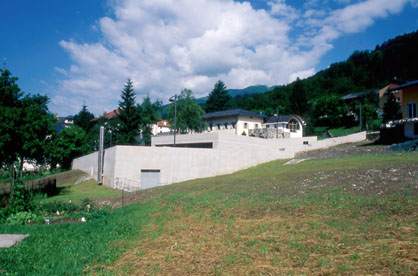 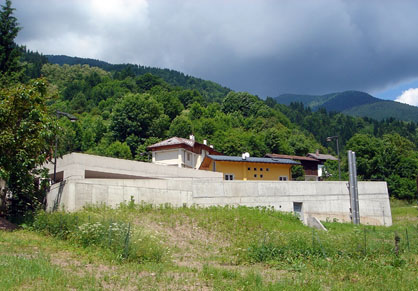 The project is in the Carnian Alps, where the onion spire of the church and the tough, articulated forms of the Town Hall by Gino Valle and the Schools by his father Provino Valle. In a way, this latest project in the family saga of civic buildings (by the current generation, Carlini & Valle) forms the trilogy. The project has been developed by Pietro Valle -who continues the family tradition with the Studio Valle architetti- and by Elena Carlini who was responsible also for the construction supervision and who says the original brief was not a particularly promising one. The Town Hall had asked for the design of a bus station and a visitors' car park, in front of the art gallery. But the architect gradually managed to convert this brief -through lateral thinking and extremely careful design- into a proper civic amenity and tangible piece of public space. |
[may 24, 2010] | ||
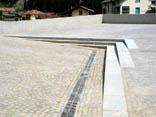  |
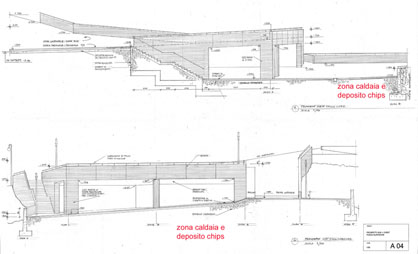 So the most immediate bit of the project is a sort of town balcony, giving the long, valley town a public square overlooking its own orchards and meadows and mountains. But it also houses a local heating system, using local timber waste to provide hot water and heating to twenty public and private buildings. It is scarcely a 'building' at all -but an exemplary piece of architecture. There is no attempt to hide its infrastructural functions. The lower level is as simple and direct as any agricultural or industrial building you might find in such a town. But it expands on its basic brief -bus stop, car park- in two directions -providing both local energy and a deliberate, generous and highly designed public space, of the type more commonly associated with the Baroque. It becomes an elegant, traditionally paved structure which is quietly strong and geometrical, with a series of 5% ramps winding gently from the slightly folded plaza down to the meadows below. |
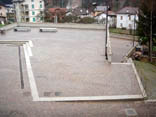 |
||
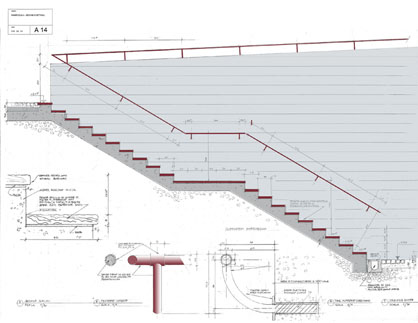 These four ramps simply and disingenuously separate different uses. The bus stop area pulls fairly steeply straight off the town's main street. But this plane then folds the other way to form an L-shaped balcony with benches overlooking the valley and meadows -or back to the town and street if you're waiting for your bus. The car ramp drops down to meadow level, and the car parking ramp itself is tilted. Underneath the square there is a covered parking for the town school bus and the social service vehicles: the rest is used for public parking. Two industrial metal doors close off the underground storage for the wood chips and the heating furnace/boiler chamber. The square and the terrace were planned wide to host the summer festivals and in winter the slopes are used by the village children for sledging. |
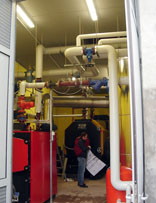  |
|||
 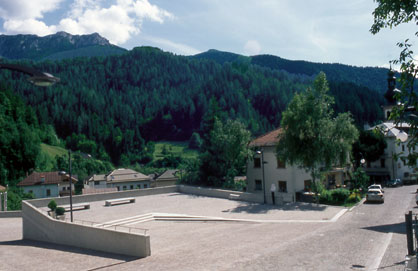 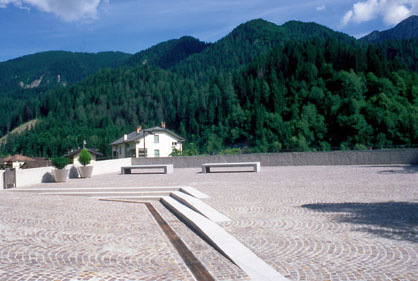 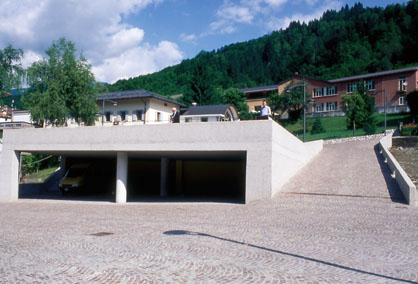 This sequence of planes -which might be an architectural conceit in another circumstances- is, in this steep mountain valley, as natural as breathing -a "continuum mobile" that slowly and panoramically takes you around and down into the meadows' as Carlini explains. Effectively, the project gives a centre to a town otherwise strung out along its rather narrow valley streets. A place to enjoy where you are. It's a project whose architectural extent and architectural modesty expands on inspection, through detail, and over time. |
 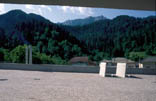    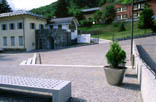 |
|||
 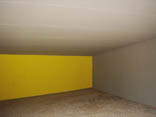 |
Though it's essentially infrastructure, its detailing is exquisite, particularly the concrete finish and the handrails: both plain and extremely tactile; right down to the breathing holes to ventilate the furnace. But it's that mix of concrete and stone cobbles which is the most overtly beautiful; the traditional fanned cobbling set seamlessly in the concrete, as though the whole project is the stripped-down plinth of a much more elaborate civic building which turned out to be entirely unnecessary. This is one of those slight projects that make a vast difference. So in a way, it does mark our era of public projects in this civic trilogy: where big public buildings may be hard to come by, but where architects can -if they are this skilled, this imaginative and this committed- improve the quality of the place and the way you can use it. Though it looks nothing like them, there's an oddly Cedric Price feel to this project: its more important for what it does than what it is. And it recalls, too a tiny version of London's Victoria Embankment: the great 19th century infrastructure project which strategised London's sewers and underground railway -and encased them all in a glorious, decorated, sunny riverside promenade. So what could have been a functional nothing -with its entirely infrastructural brief- or an overt exercise in architectural willfulness -through its folded planes and its metaphorical echoes of the valley- becomes instead, through care and imagination, a wonderfully generous project, where the most unpromising material becomes the most exquisite piece of public space. Kester Rattenbury |
|||
| CARLINI & VALLE. Piazza a Treppo Carnico |
||||
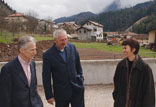 Photo by G. Montenero. |
Client: Municipality of Treppo Carnico (UD), Mayor Luigi Cortolezzis Location: Piazza della Cooperazione, Treppo Carnico (UD) Design: Carlini & Valle architetti associati, Trieste with geom. Marco Carnelutti and geom. Carlo Mauro Structures: ing. Pietro Mazzanti, Tricesimo (UD) Electrical: P.i. Zannier, Paluzza (UD) Construction supervision: arch. Elena Carlini Contractors: Edil-LEMA, di M. e L. Da Pozzo, Ravascletto (UD), general contractor Cimenti, Ovaro (UD), foundation micropoles Domenicone srl, Nimis (UD) stone paving Mario Beltrame, Treppo Carnico (UD), metal work SECAB, Paluzza (UD), electrical Metalco and Escofet, outdoor furniture Dates: Project: 2003-04 Construction: 2005-07 Opening: 2008 Costs: 400.000 Euros (Heating System excluded) Bio mass Furnace Design Ingegneria 2P, S. Donà di Piave (VE); Studio Tecnico Jud, Olang (BZ) Furnace contractor: Italplant System, Tavagnacco (UD) |
|||
| Pictures in this article are by Elena Carlini. |
||||
| Per
candidare progetti laboratorio
|
|||||